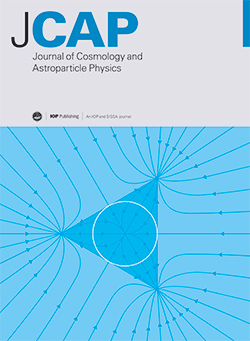轴心宇宙
IF 5.3
2区 物理与天体物理
Q1 ASTRONOMY & ASTROPHYSICS
Journal of Cosmology and Astroparticle Physics
Pub Date : 2025-03-21
DOI:10.1088/1475-7516/2025/03/050
引用次数: 0
摘要
具有几百个场的随机轴心理论有大量不同的元稳定极值。其中一小部分具有与当前暗能量测量结果相符的真空能量。该势垒还包含适合膨胀的区域,并产生了一种自然类型的暗物质。从一个最小值到另一个最小值附近的一阶相变扮演了大爆炸的角色,并产生了许多包含演化中的弗里德曼-勒梅特-罗伯逊-沃克宇宙的气泡。绝大多数气泡要么在极短的几分之一秒内坍缩,要么永远以指数形式膨胀,成为空洞的无结构宇宙。然而,如果只限于那些在其历史上的某个时期形成非线性结构的泡泡宇宙,我们就会发现它们的宇宙学与我们的宇宙学非常相似。它们经历了大约 60 埃次的膨胀,使它们变得平坦、均质和各向同性,并赋予它们一个近乎尺度不变的原始密度扰动频谱,其大小和倾斜度与观测到的大致相同。它们在膨胀后重新升温,进入辐射主导期,随后是物质主导期,丰度与观测到的大致相同,接着是真空能量主导期,密度与观测到的大致相同。这些特征在很大程度上对理论的有维和无维参数并不敏感,它们可以分别设置为大统一尺度和一阶。在我们的基准模型中,我们假定轴子势的高尺度贡献的数量并不比轴子的数量大多少,而且存在一个单一的场方向,它在这些贡献的作用下是无质量的。暗能量的小值最终来自非微扰引力效应,得出ρDE ≈ Λ4 e-𝒪(1) × M_Pl/f,其中f ≈ Λ ≈ 10-2MPl。因此,随机轴子景观可以解释我们宇宙的许多明显调整过的特征,包括其目前巨大的尺寸、年龄以及与基础物理学尺度相比极小的能量密度。本文章由计算机程序翻译,如有差异,请以英文原文为准。
The Axidental Universe
Random axion theories with several hundred fields have enormous numbers of distinct meta-stable minima. A small fraction of these have vacuum energy compatible with current measurements of dark energy. The potential also contains regions suitable for inflation, and gives rise to a natural type of dark matter. First-order phase transitions from one minimum to the vicinity of another play the role of big bangs and produce many bubbles containing evolving Friedmann-Lemaître-Robertson-Walker universes. The great majority either collapse in a tiny fraction of a second, or expand exponentially forever as empty, structureless universes. However, restricting to those bubble universes that form non-linear structure at some time in their history we find cosmologies that look remarkably similar to ours. They undergo about 60 efolds of inflation, making them flat, homogeneous and isotropic, and endowing them with a nearly scale-invariant spectrum of primordial density perturbations with roughly the observed magnitude and tilt. They reheat after inflation to a period of radiation domination, followed by matter domination with roughly the observed abundance, followed by vacuum energy domination at roughly the observed density. These features are largely insensitive to the dimensionful and dimensionless parameters of the theory, which can be set to the grand unified scale and order one respectively. In our benchmark model we assume the number of high-scale contributions to the axion potential is not much larger than the amount of axions, and that there is a single field direction which is left massless by these contributions. The small value of dark energy ultimately comes from non-perturbative gravitational effects, giving ρDE ≈ Λ4 e-𝒪(1) × M_Pl/f, where f ≈ Λ ≈ 10-2MPl. Therefore, random axion landscapes can account for many of the apparently tuned features of our universe, including its current enormous size, age, and tiny energy densities compared to the scales of fundamental physics.
求助全文
通过发布文献求助,成功后即可免费获取论文全文。
去求助
来源期刊

Journal of Cosmology and Astroparticle Physics
地学天文-天文与天体物理
CiteScore
10.20
自引率
23.40%
发文量
632
审稿时长
1 months
期刊介绍:
Journal of Cosmology and Astroparticle Physics (JCAP) encompasses theoretical, observational and experimental areas as well as computation and simulation. The journal covers the latest developments in the theory of all fundamental interactions and their cosmological implications (e.g. M-theory and cosmology, brane cosmology). JCAP''s coverage also includes topics such as formation, dynamics and clustering of galaxies, pre-galactic star formation, x-ray astronomy, radio astronomy, gravitational lensing, active galactic nuclei, intergalactic and interstellar matter.
 求助内容:
求助内容: 应助结果提醒方式:
应助结果提醒方式:


